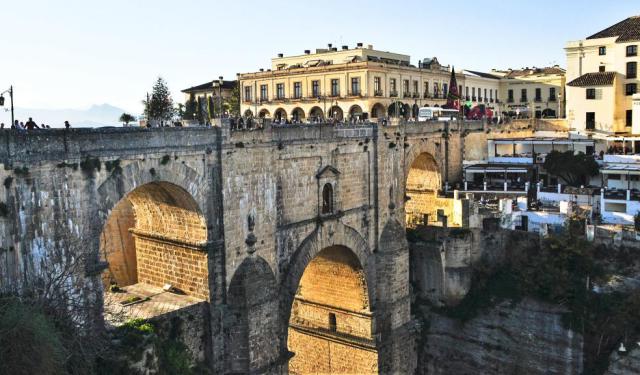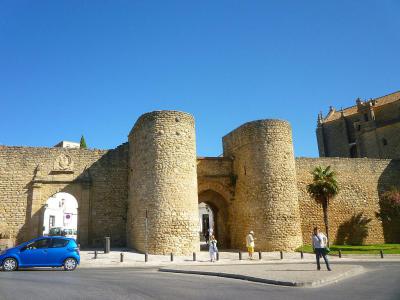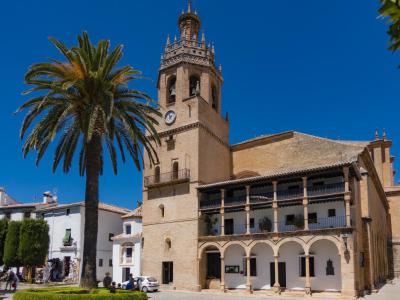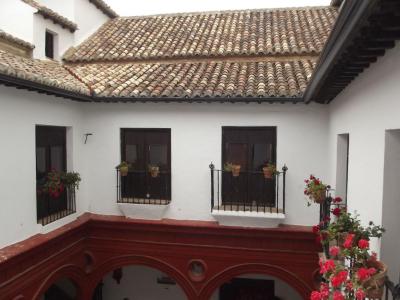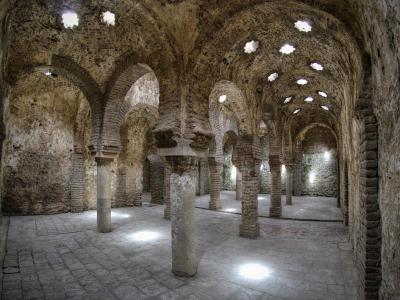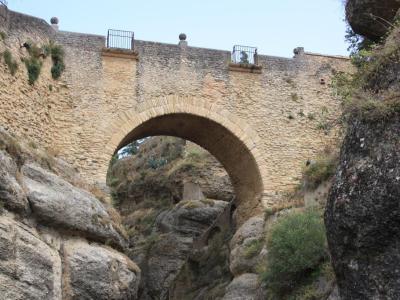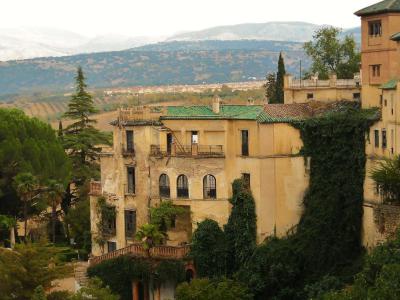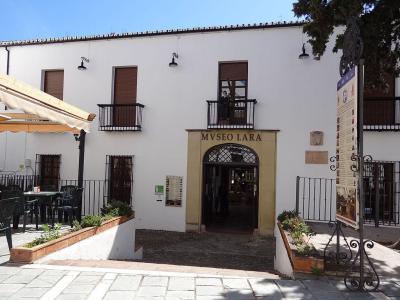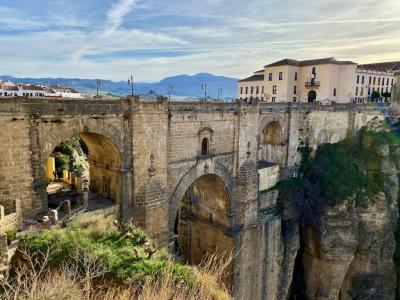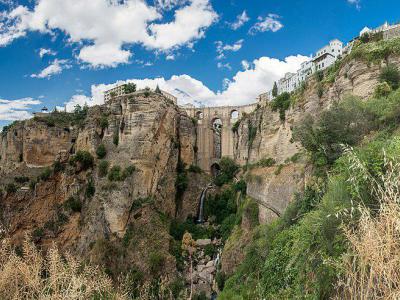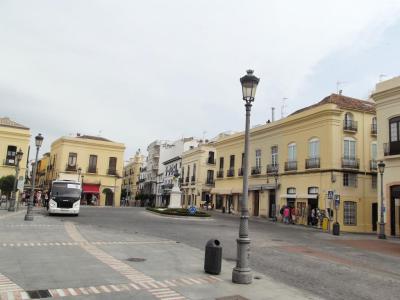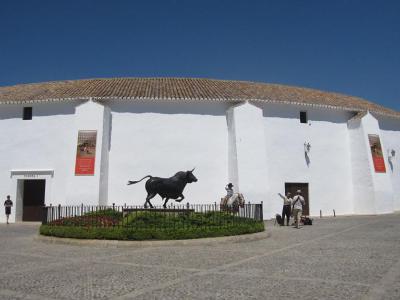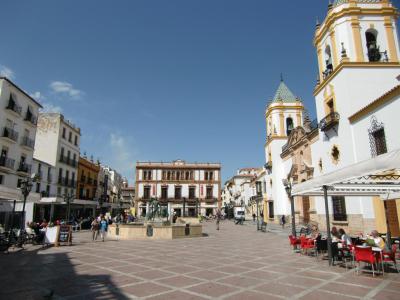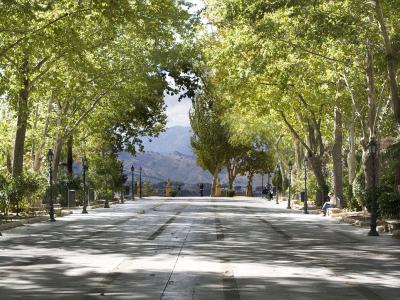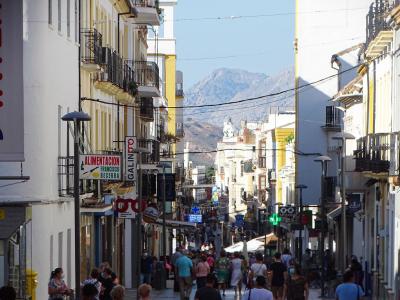Audio Guide: Ronda Introduction Walking Tour (Self Guided), Ronda
Imagine a city so dramatic it naturally inspired myth and empire-welcome to Ronda, where every cliff, gate, and square flaunts history. Before the Romans and Visigoths muscled in, Celtic tribes called this rocky promontory Arunda. The Phoenicians and Romans left their mark, but it was the Umayyads in 713 who gave us Rundah, which means the “Castle on the Cliff.” Next up, in 1485, and Rodrigo, Duke of Cádiz, storms through the Almocábar Gate-that horseshoe-arched Moorish gate-and declares the Reconquest officially scenic.
Once inside the walled old town, you’ll stumble upon the Church of Saint Mary the Elder , a Gothic-Renaissance mashup built atop a 14th-century mosque. Nearby, the Mondragón Palace stands cool and white, its tile-lined patios and courtyards now home to the municipal museum. Don’t miss the neighboring, Spain's best preserved Arab Baths-where vaulted chambers once soothed Moorish elites (Muslim rulers and inhabitants of North African origin who controlled parts of Spain from the 8th to the 15th century).
But Ronda’s showpiece is the Ronda Gorge, a 329-foot split carved by the River Guadalevín. Old Bridge (dated to 1616) offers a quaint peek over a side ravine, while the soaring New Bridge (finished in 1793) spans the chasm like a stone ribbon, its viewing chamber tucked into the central arch-perfect for dramatic photos. Below, a rocky path from Mary Help of Christians Square leads you to the riverbed for a hardcore “bridge selfie.”
Venture into the House of the Moorish King , where artificial grottoes and a restored water mine once fed palace gardens. A short stroll away, the Lara Museum delights with film props, archaeological relics, and a dash of pop culture. Then there’s the heartbeat of Ronda-its squares. Spain Square and Socorro Square are shaded by plane trees and ringed with cafés ideal for sipping regional wine. History buffs will pause at the bullring, one of Spain’s oldest, before wandering Espinel street, Ronda’s shopping artery crammed with local crafts and boutiques.
When the sun dips, head to the Gorge Promenade-where the valley’s olive groves and whitewashed villages stretch to the horizon.
From Moorish gate to bullring ring, Ronda is living history with a side of adrenaline. Switch from dress shoes to the unbeatable sneakers, charge your camera, and come lose yourself in one of Andalusia’s greatest cliffhangers.
Once inside the walled old town, you’ll stumble upon the Church of Saint Mary the Elder , a Gothic-Renaissance mashup built atop a 14th-century mosque. Nearby, the Mondragón Palace stands cool and white, its tile-lined patios and courtyards now home to the municipal museum. Don’t miss the neighboring, Spain's best preserved Arab Baths-where vaulted chambers once soothed Moorish elites (Muslim rulers and inhabitants of North African origin who controlled parts of Spain from the 8th to the 15th century).
But Ronda’s showpiece is the Ronda Gorge, a 329-foot split carved by the River Guadalevín. Old Bridge (dated to 1616) offers a quaint peek over a side ravine, while the soaring New Bridge (finished in 1793) spans the chasm like a stone ribbon, its viewing chamber tucked into the central arch-perfect for dramatic photos. Below, a rocky path from Mary Help of Christians Square leads you to the riverbed for a hardcore “bridge selfie.”
Venture into the House of the Moorish King , where artificial grottoes and a restored water mine once fed palace gardens. A short stroll away, the Lara Museum delights with film props, archaeological relics, and a dash of pop culture. Then there’s the heartbeat of Ronda-its squares. Spain Square and Socorro Square are shaded by plane trees and ringed with cafés ideal for sipping regional wine. History buffs will pause at the bullring, one of Spain’s oldest, before wandering Espinel street, Ronda’s shopping artery crammed with local crafts and boutiques.
When the sun dips, head to the Gorge Promenade-where the valley’s olive groves and whitewashed villages stretch to the horizon.
From Moorish gate to bullring ring, Ronda is living history with a side of adrenaline. Switch from dress shoes to the unbeatable sneakers, charge your camera, and come lose yourself in one of Andalusia’s greatest cliffhangers.
How it works: Download the app "GPSmyCity: Walks in 1K+ Cities" from Apple App Store or Google Play Store to your mobile phone or tablet. The app turns your mobile device into a personal tour guide and its built-in GPS navigation functions guide you from one tour stop to next. The app works offline, so no data plan is needed when traveling abroad.
Ronda Introduction Walking Tour Map
Guide Name: Ronda Introduction Walking Tour
Guide Location: Spain » Ronda (See other walking tours in Ronda)
Guide Type: Self-guided Walking Tour (Sightseeing)
# of Attractions: 14
Tour Duration: 2 Hour(s)
Travel Distance: 2.8 Km or 1.7 Miles
Author: DanaOffice
Sight(s) Featured in This Guide:
Guide Location: Spain » Ronda (See other walking tours in Ronda)
Guide Type: Self-guided Walking Tour (Sightseeing)
# of Attractions: 14
Tour Duration: 2 Hour(s)
Travel Distance: 2.8 Km or 1.7 Miles
Author: DanaOffice
Sight(s) Featured in This Guide:
- Puerta del Almocabar (Almocabar Gate)
- Iglesia de Santa Maria la Mayor (Church of Saint Mary the Elder)
- Palacio de Mondragon (Mondragon Palace)
- Banos Arabes de Ronda (Arab Baths of Ronda)
- Puente Viejo (Old Bridge)
- Casa del Rey Moro (House of the Moorish King)
- Museo Lara (Lara Museum)
- Puente Nuevo (New Bridge)
- Tajo de Ronda (Ronda Gorge)
- Plaza de Espana (Spain Square)
- Plaza de Toros de Ronda (Ronda Bullring)
- Plaza del Socorro (Socorro Square)
- Alameda del Tajo (Gorge Promenade)
- Carrera Espinel Shopping Street
1) Puerta del Almocabar (Almocabar Gate)
On May 20, 1485, Ferdinand the Catholic (monarch of Spain, led the Reconquest of the Iberian Peninsula from muslim rule) led his Aragonese troops through Ronda’s formidable walls via the Almocábar Gate, a 13th-century portal whose name cheekily hints at its neighbor: “al-macabre,” or “the cemetery,” because nothing says welcome like a Muslim graveyard just outside the gate.
This south-wall gate, with its trio of recessed Gothic arches flanked by twin semicircular towers, opened into the Arrabal Alto, the old Islamic suburb now dubbed the District of the Holy Spirit-where, fittingly, you’ll find the Church of the Holy Spirit placed atop an ancient mosque. If walls could talk, these would brag about surviving Napoleon’s 1808 rampage (spoiler - they didn’t), then patiently wait until the 1960s for a full makeover.
Today, the plaza in front of the gate is easy to stroll through and full of life, ringed with cozy restaurants, lively bars, and even a children’s playground-perfect for working off those churros. It's better to show up before 2 PM on holidays if you want a primo vantage point. After all, history’s more fun when you’ve scored the best seat in the house.
This south-wall gate, with its trio of recessed Gothic arches flanked by twin semicircular towers, opened into the Arrabal Alto, the old Islamic suburb now dubbed the District of the Holy Spirit-where, fittingly, you’ll find the Church of the Holy Spirit placed atop an ancient mosque. If walls could talk, these would brag about surviving Napoleon’s 1808 rampage (spoiler - they didn’t), then patiently wait until the 1960s for a full makeover.
Today, the plaza in front of the gate is easy to stroll through and full of life, ringed with cozy restaurants, lively bars, and even a children’s playground-perfect for working off those churros. It's better to show up before 2 PM on holidays if you want a primo vantage point. After all, history’s more fun when you’ve scored the best seat in the house.
2) Iglesia de Santa Maria la Mayor (Church of Saint Mary the Elder)
Nestled on the footprint of a 13th-century mosque-and a Visigothic ( they were Germanic tribes, known for the sacking of Rome ) church before that-the Church of Saint Mary the Elder stands in Duchess of Parcent Square, named for one of Spain’s first female deputies. Despite its holy purpose, that quirky tower and civic-style façade might have you wondering if you’ve stumbled into the town hall by mistake.
Step inside and you’ll find a vestibule boasting one of the original columns from the post-1485 cathedral-if only it could tell stories of that 1580 earthquake that crumbled its predecessor. Behind the altar, you can still spot a reminder of its time as a mosque-a mihrab niche and a wall decorated with intricate plant-like patterns, quietly recalling the days of Islamic prayer before church bells took over.
The building you see today is largely Renaissance, but Gothic ghosts linger in the ogival arches and sturdy columns. Late-16th-century balconies-added under Philip II for Cavalry School noble spectators-still hover above the street, as if waiting for the next joust. Up in the choir loft, two tiers of cedar and walnut seats are carved with Mary’s symbols, apostles, and saints, all gazing down at a Baroque altarpiece of Our Lady of Great Sorrow. It’s a mash-up of faith, history, and architectural remix that proves: in Ronda, churches enjoy a multi-layered past.
Step inside and you’ll find a vestibule boasting one of the original columns from the post-1485 cathedral-if only it could tell stories of that 1580 earthquake that crumbled its predecessor. Behind the altar, you can still spot a reminder of its time as a mosque-a mihrab niche and a wall decorated with intricate plant-like patterns, quietly recalling the days of Islamic prayer before church bells took over.
The building you see today is largely Renaissance, but Gothic ghosts linger in the ogival arches and sturdy columns. Late-16th-century balconies-added under Philip II for Cavalry School noble spectators-still hover above the street, as if waiting for the next joust. Up in the choir loft, two tiers of cedar and walnut seats are carved with Mary’s symbols, apostles, and saints, all gazing down at a Baroque altarpiece of Our Lady of Great Sorrow. It’s a mash-up of faith, history, and architectural remix that proves: in Ronda, churches enjoy a multi-layered past.
3) Palacio de Mondragon (Mondragon Palace)
Abomelik, a 14th-century Muslim military commander and unofficial Ronda guest of honor-didn’t commission the Mondragón Palace. Still, after his triumphant Gibraltar victories in 1330, he did take up temporary residence here-only to dash off to his final curtain call at the Battle of Jerez in 1338.
Today’s palace is less medieval fortress and more time-traveler’s mash-up. Beneath 18th-century wings and a modern front gallery (thank you, Ferdinand and Isabella, circa 1490s), you’ll see wooden Mudéjar-style ceilings, colorful original ceramic tiles, and open balconies looking out over peaceful inner courtyards.
However, the true attraction are the cliff-hanging water gardens, still whispering of Moorish luxury and now moonlighting as Ronda’s favorite spot for sculpture expos and wedding “I do’s.”
Inside, the upper floor hosts the Ronda’s Museum of Local History , where artifacts chart millennia of Andalusian drama-from Roman rule to Moorish reign to Catholic monarch makeovers-while the rest of the palace doubles as the town’s School of Languages. Walk these halls long enough, and you’ll swear you can hear Abomelik grumbling about overdue rent.
Today’s palace is less medieval fortress and more time-traveler’s mash-up. Beneath 18th-century wings and a modern front gallery (thank you, Ferdinand and Isabella, circa 1490s), you’ll see wooden Mudéjar-style ceilings, colorful original ceramic tiles, and open balconies looking out over peaceful inner courtyards.
However, the true attraction are the cliff-hanging water gardens, still whispering of Moorish luxury and now moonlighting as Ronda’s favorite spot for sculpture expos and wedding “I do’s.”
Inside, the upper floor hosts the Ronda’s Museum of Local History , where artifacts chart millennia of Andalusian drama-from Roman rule to Moorish reign to Catholic monarch makeovers-while the rest of the palace doubles as the town’s School of Languages. Walk these halls long enough, and you’ll swear you can hear Abomelik grumbling about overdue rent.
4) Banos Arabes de Ronda (Arab Baths of Ronda) (must see)
The Arab Baths of Ronda-or Hammams, as the locals call them-are a bit of a dating mystery: some whisper they sprang up in the 1100s or 1200s, while others insist they’re a 14th-century showpiece of Sultan Abomelik’s reign. Sitting just outside Ronda’s walls beside the Arabic Bridge, these baths still show off their original pump tower and aqueduct like proud badges.
Here’s how it worked: a trusty donkey trotted atop the irrigator, turning a massive wheel to lift river water up from the dizzying depths of the Guadalevín Gorge-or the even more dramatic Canyon of Snakes-and into the aqueduct feeding the baths. Step inside the compound and you’ll spot the ramped tower on your right, where that same water tumbled into the hot rooms of the hammam.
Once inside, you’ll find the classic three-zone setup-cold plunge, warm soak, and steam-purifying hot room-separated by four pairs of elegant horseshoe arches. Overhead, star-shaped skylights pierce the vaulted roofs, sprinkling sunlight onto brick and stone columns like celestial chandeliers. It’s basically Ronda’s original spa day, with a side of medieval engineering and cliffside drama.
Here’s how it worked: a trusty donkey trotted atop the irrigator, turning a massive wheel to lift river water up from the dizzying depths of the Guadalevín Gorge-or the even more dramatic Canyon of Snakes-and into the aqueduct feeding the baths. Step inside the compound and you’ll spot the ramped tower on your right, where that same water tumbled into the hot rooms of the hammam.
Once inside, you’ll find the classic three-zone setup-cold plunge, warm soak, and steam-purifying hot room-separated by four pairs of elegant horseshoe arches. Overhead, star-shaped skylights pierce the vaulted roofs, sprinkling sunlight onto brick and stone columns like celestial chandeliers. It’s basically Ronda’s original spa day, with a side of medieval engineering and cliffside drama.
5) Puente Viejo (Old Bridge)
Ronda’s old quarter is literally split in two by a jaw-dropping 394-foot gorge carved by the River Guadalevín. Bridging this cliff-side drama are three spans, and the Old Bridge is the runt of the trio-dating from 1616, it’s strictly a footpath and once the sole link between the Lower Market and the Old Town.
Don’t let its “Old” label fool you; it’s second in age to the fabled Roman Bridge. This slender 33-foot arch rises a lofty 102 feet above the river bed, its balustrades and lookout balconies refreshed in an 18th-century makeover. Midway across, four small viewing platforms invite you to pause for a selfie or two-while the north side spills into terraced gardens that climb toward the New Bridge, the south side greets you with the ornate Gate of Philip V, and the east cheekily reveals the ruins of medieval arab baths.
Don’t let its “Old” label fool you; it’s second in age to the fabled Roman Bridge. This slender 33-foot arch rises a lofty 102 feet above the river bed, its balustrades and lookout balconies refreshed in an 18th-century makeover. Midway across, four small viewing platforms invite you to pause for a selfie or two-while the north side spills into terraced gardens that climb toward the New Bridge, the south side greets you with the ornate Gate of Philip V, and the east cheekily reveals the ruins of medieval arab baths.
6) Casa del Rey Moro (House of the Moorish King)
Believe it or not, not a single Moorish monarch ever set foot in the so-called House of the Moorish King. Erected in the 18th century-well after Ronda’s last Moorish commander, rode off into exile in 1487-this swaggering villa owes its name more to legend than to royal residency. Its lush gardens, though, are 20th-century French flair, laid out by Jean Claude Forestier in 1912 to rival even the grandest Andalusian patios.
The true medieval star here is the Water Mine, a 14th-century marvel King Abomelik commissioned to carve stairs down the sheer gorge walls so wagons could haul river water uphill. Sadly, in 1485 the Marquis of Cádiz’s troops sabotaged the wheel, and with the city’s water supply cut, Ronda waved the white flag.
Today’s complex is a three-act drama: the subterranean Water Mine, the 18th-century house perched above it, and Forestier’s picture-perfect gardens. The Duchess of Parcent snapped up the property in 1911, gave the villa a grand makeover, and hired Forestier to green up the grounds. The result? A historic estate where Moorish engineering shakes hands with Rococo makeovers, all set in Belle Époque gardens - they are begging you to explore its hidden stairways and blooming courtyards.
The true medieval star here is the Water Mine, a 14th-century marvel King Abomelik commissioned to carve stairs down the sheer gorge walls so wagons could haul river water uphill. Sadly, in 1485 the Marquis of Cádiz’s troops sabotaged the wheel, and with the city’s water supply cut, Ronda waved the white flag.
Today’s complex is a three-act drama: the subterranean Water Mine, the 18th-century house perched above it, and Forestier’s picture-perfect gardens. The Duchess of Parcent snapped up the property in 1911, gave the villa a grand makeover, and hired Forestier to green up the grounds. The result? A historic estate where Moorish engineering shakes hands with Rococo makeovers, all set in Belle Époque gardens - they are begging you to explore its hidden stairways and blooming courtyards.
7) Museo Lara (Lara Museum)
The Lara Museum unfolds as an eccentric cabinet of curiosities shaped by the lifelong collecting habit of Juan Lara. His fascination began at age ten with a handful of coins and snowballed into a sprawling collection that now fills this old city residence from floor to rafters. On the upper levels, glass cases brim with antique watches, vintage firearms, clunky typewriters, and microscopes polished to perfection. One room might feel like a gentleman’s study, the next like a time capsule packed by a particularly enthusiastic hoarder.
Downstairs, the tone shifts. Here, Juan leans fully into the macabre. Mannequins dressed as Inquisitors loom over medieval torture devices, their polished metal surfaces catching the low light just enough to raise a few hairs. Around the corner, a bug-eyed witch stirs her cauldron, flanked by improbable creatures that blur the line between folklore and fever dream. It’s theatrical, unnerving, and strangely captivating.
The Lara Museum isn’t trying to be neat or conventional. It’s part private archive, part haunted playhouse-and all powered by one man’s remarkable eye for the bizarre.
Downstairs, the tone shifts. Here, Juan leans fully into the macabre. Mannequins dressed as Inquisitors loom over medieval torture devices, their polished metal surfaces catching the low light just enough to raise a few hairs. Around the corner, a bug-eyed witch stirs her cauldron, flanked by improbable creatures that blur the line between folklore and fever dream. It’s theatrical, unnerving, and strangely captivating.
The Lara Museum isn’t trying to be neat or conventional. It’s part private archive, part haunted playhouse-and all powered by one man’s remarkable eye for the bizarre.
8) Puente Nuevo (New Bridge) (must see)
You might think “Puente Nuevo” means “Brand-New Bridge,” but in Ronda it’s more of a “Third Time’s the Charm” Bridge. The first go at crossing the Guadalevín Gorge was a single-arch affair in 1735-and it spectacularly collapsed in 1741, taking 50 unfortunate souls with it. Oops.
Enter Andalusian architect Martín de Aldehuela, who, in 1793, erected the soaring three-arch marvel you see today. The towering central span, bookended by two smaller arches, stands nearly 100 meters above the river, linking the Little Market with the Old Town. It even boasts a secret chamber found above the keystone-once a prison and torture chamber during the Civil War, now a guardhouse-turned-mini museum chronicling the bridge’s dramatic history.
Legend has it King Philip V dreamed up a new crossing in 1735 to ease traffic alongside the sleepy 16th-century Old Bridge and the ancient 12th-century Moorish bridge by the Arab Baths. Today, the New Bridge is Ronda’s headline act: flanked by pedestrian walkways and lined with benches, it commands jaw-dropping views-and a modest admission fee-to marvel at where a once-fatal flop became an enduring icon.
Enter Andalusian architect Martín de Aldehuela, who, in 1793, erected the soaring three-arch marvel you see today. The towering central span, bookended by two smaller arches, stands nearly 100 meters above the river, linking the Little Market with the Old Town. It even boasts a secret chamber found above the keystone-once a prison and torture chamber during the Civil War, now a guardhouse-turned-mini museum chronicling the bridge’s dramatic history.
Legend has it King Philip V dreamed up a new crossing in 1735 to ease traffic alongside the sleepy 16th-century Old Bridge and the ancient 12th-century Moorish bridge by the Arab Baths. Today, the New Bridge is Ronda’s headline act: flanked by pedestrian walkways and lined with benches, it commands jaw-dropping views-and a modest admission fee-to marvel at where a once-fatal flop became an enduring icon.
9) Tajo de Ronda (Ronda Gorge) (must see)
Ronda’s soul is literally split in two by the Ronda Gorge, a gaping 394-foot fissure carved by the stubborn Guadalevín River as it rushes down from the Snowy Mountains. On one rim sits the storybook Moorish Old Town, and on the other, the bustling Little Market of modern life. Down at the bottom, you can spy the river’s ancient trickle powering ruined flour mills-victims of the great 1917 landslide-while steep trails beckon the brave to clamber alongside the canyon walls.
Spanning this vertical drama is the New Bridge, its Romanesque arches soaring almost 100 meters above the torrent. From the bridge’s edge, your gaze sweeps across the entire gorge, the valley below, and even the Grazalema Mountains on a clear day. Fancy a closer look? Start at the Roman Bridge and follow the rugged east-bank trail down to tranquil ponds linked by old mill canals. If you’d rather stay dry, pop into Hostel Los Molinos-housed in a restored water mill-for prime viewing of the west cliff face.
For a real hydraulic thrill, descend the Water Mine steps at the House of the Moorish King, where 14th-century engineers carved a well all the way down to river level. Legend says Christian slaves climbed those same stairs carrying water skins-proof that Ronda’s eagerness for lofty views goes back centuries.
Old customs may be as stubborn as the stone walls, but one thing’s timeless: Ronda’s views are simply unbeatable.
Spanning this vertical drama is the New Bridge, its Romanesque arches soaring almost 100 meters above the torrent. From the bridge’s edge, your gaze sweeps across the entire gorge, the valley below, and even the Grazalema Mountains on a clear day. Fancy a closer look? Start at the Roman Bridge and follow the rugged east-bank trail down to tranquil ponds linked by old mill canals. If you’d rather stay dry, pop into Hostel Los Molinos-housed in a restored water mill-for prime viewing of the west cliff face.
For a real hydraulic thrill, descend the Water Mine steps at the House of the Moorish King, where 14th-century engineers carved a well all the way down to river level. Legend says Christian slaves climbed those same stairs carrying water skins-proof that Ronda’s eagerness for lofty views goes back centuries.
Old customs may be as stubborn as the stone walls, but one thing’s timeless: Ronda’s views are simply unbeatable.
10) Plaza de Espana (Spain Square)
Right next to the New Bridge lies the Spain Square-a name that might sound generic, but this square is anything but. While plenty of towns across Spain have one, Ronda’s version stands dramatically at the edge of a cliff, offering open views straight into the gorge below. It’s more adrenaline than average, especially if you’re not a fan of heights.
In the 18th century, this square hosted the Town Hall; today, that same building houses the upscale Parador Hotel. The square still carries the weight of Ronda’s long history, balanced with everyday life-complete with café terraces, slow coffees, and even a McDonald’s that somehow doesn’t ruin the atmosphere. At its center stands the statue of Ríos Rosas, a 19th-century politician keeping silent watch over the square.
Literature lovers might recognize this very place from Hemingway’s For Whom the Bell Tolls. The novel’s most harrowing scene-where fascist sympathizers are thrown off a cliff-was inspired by real events that unfolded here during the Spanish Civil War. It’s a peaceful spot now, but the stories it holds run deep.
In the 18th century, this square hosted the Town Hall; today, that same building houses the upscale Parador Hotel. The square still carries the weight of Ronda’s long history, balanced with everyday life-complete with café terraces, slow coffees, and even a McDonald’s that somehow doesn’t ruin the atmosphere. At its center stands the statue of Ríos Rosas, a 19th-century politician keeping silent watch over the square.
Literature lovers might recognize this very place from Hemingway’s For Whom the Bell Tolls. The novel’s most harrowing scene-where fascist sympathizers are thrown off a cliff-was inspired by real events that unfolded here during the Spanish Civil War. It’s a peaceful spot now, but the stories it holds run deep.
11) Plaza de Toros de Ronda (Ronda Bullring) (must see)
Ronda didn’t just invent cliffside drama with its bridges-it also staged Spain’s very first bullfight in May 1784. The debut was so thrilling that the stands partially gave way under the excitement, prompting a do-over the next year. That second edition went off without a hitch, starring legends Pedro Romero and Pepe Hillo who squared off before Ronda’s spectacle-seeking crowd.
Just two blocks from the New Bridge, the bullring stands proudly, its brick-and-stone façade designed by Martín de Aldehuela. While it only seats about 5,000 spectators-cozy by modern standards-its arena floor is the largest in Spain, giving bulls extra room to strut their stuff. Under the surrounding gallery arches, you’ll find the Bullfighting Museum, where two centuries of torero capes, shiny swords, ornate lances, and even Royal Cavalry gear tell the story of how Ronda’s bullfighting shifted from horseback to on foot.
Every September, Ronda turns back the clock for the Pedro Romero Festival, a week-long flamenco festival, 18th-century finery, and matador pageantry. Named after the original foot-fighting pioneer, Pedro Romero, and immortalized in Goya’s brushstrokes, the fair ends with blockbuster bullfights under the same skies that once awed Orson Welles and Ernest Hemingway-whose ashes now mingle with Ronda’s sandy ring. Talk about leaving your mark!
Just two blocks from the New Bridge, the bullring stands proudly, its brick-and-stone façade designed by Martín de Aldehuela. While it only seats about 5,000 spectators-cozy by modern standards-its arena floor is the largest in Spain, giving bulls extra room to strut their stuff. Under the surrounding gallery arches, you’ll find the Bullfighting Museum, where two centuries of torero capes, shiny swords, ornate lances, and even Royal Cavalry gear tell the story of how Ronda’s bullfighting shifted from horseback to on foot.
Every September, Ronda turns back the clock for the Pedro Romero Festival, a week-long flamenco festival, 18th-century finery, and matador pageantry. Named after the original foot-fighting pioneer, Pedro Romero, and immortalized in Goya’s brushstrokes, the fair ends with blockbuster bullfights under the same skies that once awed Orson Welles and Ernest Hemingway-whose ashes now mingle with Ronda’s sandy ring. Talk about leaving your mark!
12) Plaza del Socorro (Socorro Square)
Ronda’s Socorro Square is where locals caffeinate, politicians pontificate, and tourists marvel at the perkiness of underground parking hidden beneath cobblestones. Ringed by bustling cafés and tapas bars, it’s hard to resist the call of an espresso or a plate of marinated anchovies while watching the world swirl around the central fountain.
Dominating one side of the plaza is the Church of Help rebuilt after the 1936 blaze that toasted its predecessor first consecrated in 1557. But Plaza del Socorro isn’t just about divine intervention; in 1918 it became the stage for Blas Infante, Andalusia’s “Father of the Homeland,” who unfurled the green-and-white banner of Andalusian nationalism from the Artists’ Society balcony, shouting “Long live a free Andalusia!”.
Looking over the square is a statue of Hercules standing between two lions, symbolizing the Pillars of Hercules and Ronda’s connection to ancient Mediterranean myths. It’s a quiet tribute to the city’s legendary past.
In Socorro Square, history and tradition blend with everyday life, where locals gather over coffee and conversation in the heart of the city.
Dominating one side of the plaza is the Church of Help rebuilt after the 1936 blaze that toasted its predecessor first consecrated in 1557. But Plaza del Socorro isn’t just about divine intervention; in 1918 it became the stage for Blas Infante, Andalusia’s “Father of the Homeland,” who unfurled the green-and-white banner of Andalusian nationalism from the Artists’ Society balcony, shouting “Long live a free Andalusia!”.
Looking over the square is a statue of Hercules standing between two lions, symbolizing the Pillars of Hercules and Ronda’s connection to ancient Mediterranean myths. It’s a quiet tribute to the city’s legendary past.
In Socorro Square, history and tradition blend with everyday life, where locals gather over coffee and conversation in the heart of the city.
13) Alameda del Tajo (Gorge Promenade)
Once called the San Carlos Promenade, the Gorge Promenade is Ronda’s 19th-century walkway lined with Himalayan cedars, stone pines, and honey locusts-some of which have stood long enough to “remember” the 18th-century bridge collapse. Located beside the bullring and running along the edge of the Tajo Gorge, the promenade was planted with intention: each row of trees was named after the child born on the day the saplings were set in the ground. Today, those so-called “birthday trees” shade five landscaped paths that lead to dramatic viewpoints overlooking the gorge and the distinctively shaped Calderón Handle rock formation.
Along the way, several statues mark the route. There’s the Goyesque Lady by sculptor Francisco Parra, dressed in period attire, and a figure of Pedro Romero, Ronda’s famous bullfighter, cast in a confident stance. A few smaller sculptures of winged figures add a quiet presence to the landscape.
For those wanting to explore further, the English Path descends toward the gardens of the nearby Hotel Catalonia, while the Path of the Limes offers a more fragrant route through citrus trees. At the end of the promenade, the Vicente Espinel Municipal Theater stands out with its mix of brick, columns, and glass, just steps from the open-air stage and scenic overlooks of the Gardens of Blas Infante.
Here, Ronda’s natural beauty and cultural landmarks come together in one of the city’s most memorable public spaces-proof that sometimes even famous theaters can be overshadowed.
Along the way, several statues mark the route. There’s the Goyesque Lady by sculptor Francisco Parra, dressed in period attire, and a figure of Pedro Romero, Ronda’s famous bullfighter, cast in a confident stance. A few smaller sculptures of winged figures add a quiet presence to the landscape.
For those wanting to explore further, the English Path descends toward the gardens of the nearby Hotel Catalonia, while the Path of the Limes offers a more fragrant route through citrus trees. At the end of the promenade, the Vicente Espinel Municipal Theater stands out with its mix of brick, columns, and glass, just steps from the open-air stage and scenic overlooks of the Gardens of Blas Infante.
Here, Ronda’s natural beauty and cultural landmarks come together in one of the city’s most memorable public spaces-proof that sometimes even famous theaters can be overshadowed.
14) Carrera Espinel Shopping Street
Right in the heart of Ronda’s old town, Carrera Espinel-though most locals simply call it La Bola-is the city’s go-to shopping strip. Stretching about a kilometer through the historic quarter, this cobbled walkway hums with energy, flanked by clothing shops, tapas bars, bakeries, and souvenir stands. It’s the lifeblood of The Market District, Ronda’s unofficial retail district, where window-shopping can easily turn into a full-day affair.
Its official name pays tribute to Vicente Espinel, the city’s multi-talented 16th-century priest, poet, and musician who helped shape Spain’s Golden Age (period of cultural flourishing between the 15th and 17th century). But the nickname La Bola carries a more colorful legacy. One story involves kids sending an enormous snowball racing down the slope, to the delight (or alarm) of everyone in its path. Another version speaks of a traditional street game involving a hefty 3-kilogram iron ball rolled stroke by stroke-part sport, part test of brawn, and likely the noisiest way to spend an afternoon.
La Bola may be paved in modern storefronts, but it still carries the charm-and a few stories-of old Ronda. It’s where commerce meets folklore, and where you’re just as likely to leave with a shopping bag as you are with a new bit of local legend.
Its official name pays tribute to Vicente Espinel, the city’s multi-talented 16th-century priest, poet, and musician who helped shape Spain’s Golden Age (period of cultural flourishing between the 15th and 17th century). But the nickname La Bola carries a more colorful legacy. One story involves kids sending an enormous snowball racing down the slope, to the delight (or alarm) of everyone in its path. Another version speaks of a traditional street game involving a hefty 3-kilogram iron ball rolled stroke by stroke-part sport, part test of brawn, and likely the noisiest way to spend an afternoon.
La Bola may be paved in modern storefronts, but it still carries the charm-and a few stories-of old Ronda. It’s where commerce meets folklore, and where you’re just as likely to leave with a shopping bag as you are with a new bit of local legend.
The Most Popular Cities
/ view all
